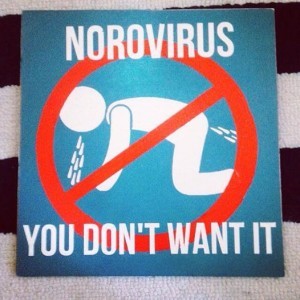Norovirus kind of sucks, unless you are a virologist. The perfect human pathogen (a term coined by my NoroCORE colleague and all-around good guy, Aron Hall) is shed at a crazy high rate of virus particles per gram of vomit or feces and sticks around in the environment for a long time. So outbreaks tend to persist and hit college campuses where lots of people live and eat together.
Like USC, where, according to LAist, a lot of students are sick.
The Los Angeles County Department of Public Health has confirmed that they are currently investigating a norovirus outbreak at the University of Southern California. A representative from the Department of Public Health told LAist that 103 cases have been reported since October 26, which is when the university reached out to the department about the situation.
The university has asked students to remain home from classes or social events until they’ve been symptom free for at least 24 hours, according to a post on the USC Engemann Student Health Center website. This isn’t the first time the student body has been struck down by the virus—in 2008 hundreds of cases were reported in 2008, and there were a number of outbreaks around the L.A. area last year, as well.
Brae Surgeoner, Doug and I had a paper published in the Journal of Environmental Health about some research we conducted in the Winter of 2006. The study came about because a whole bunch of kids in the University of Guelph’s residence system started puking from an apparent norovirus outbreak. There were lots of handwashing signs up and we wanted to know whether they changed hygiene behavior (especially if kids were using the tools available when entering the cafeteria). Turns out that students weren’t doing as good of a job at hand hygiene as they reported to us.






 The New York Times today
The New York Times today investigation will help pinpoint the suspected food vehicle.
investigation will help pinpoint the suspected food vehicle. Last year, some publication at the University of California at Los Angeles – UCLA – warned students that beer pong, a communal drinking game,
Last year, some publication at the University of California at Los Angeles – UCLA – warned students that beer pong, a communal drinking game, 
 Julie, my youngest sister, started her first year at Fanshawe College in London (Ontario) this fall. Like many first years she’s staying in residence, and like many first years she’s having a great drunken time – likely followed by painful mornings hovered over the toilet.
Julie, my youngest sister, started her first year at Fanshawe College in London (Ontario) this fall. Like many first years she’s staying in residence, and like many first years she’s having a great drunken time – likely followed by painful mornings hovered over the toilet..jpg) As thousands of American college students prepare for their first classes this morning, Doug makes pizza and tries to answer the question:
As thousands of American college students prepare for their first classes this morning, Doug makes pizza and tries to answer the question:  When was the last time you opened your fridge and saw this- the mold monster? Hopefully never, but if you have, you’ve probably experienced some sort of sickness related to eating the food from the fridge. Mold grows from decomposing organic material, and in addition to a foul order and slime, mold is a great indicator of food going bad. But food can be decidedly “bad” before the mold fully appears.
When was the last time you opened your fridge and saw this- the mold monster? Hopefully never, but if you have, you’ve probably experienced some sort of sickness related to eating the food from the fridge. Mold grows from decomposing organic material, and in addition to a foul order and slime, mold is a great indicator of food going bad. But food can be decidedly “bad” before the mold fully appears. 